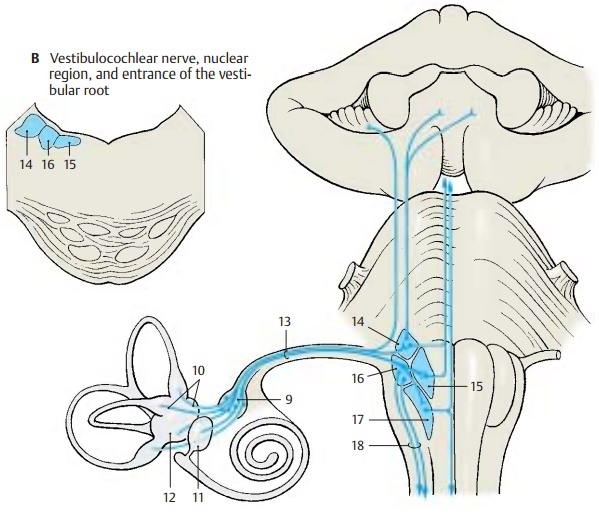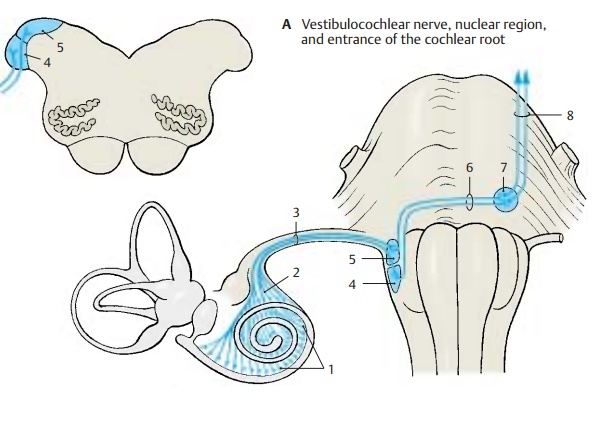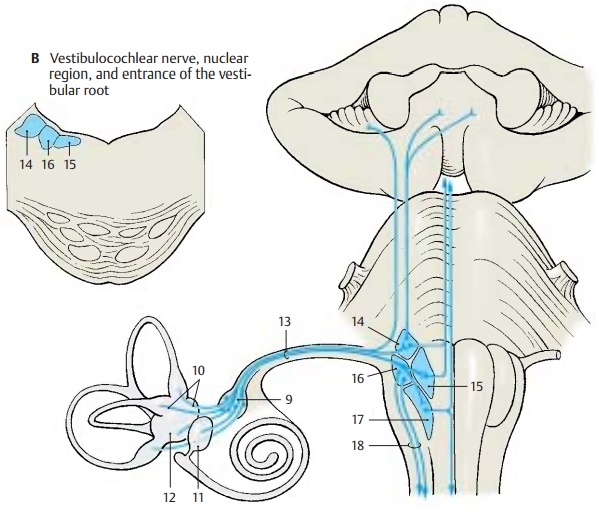Chapter: Human Nervous System and Sensory Organs : Brain Stem and Cranial Nerves
Vestibulocochlear Nerve - Cranial Nerves (V, VII - XII)

Vestibulocochlear Nerve
The eighth cranial nerve is an afferentnerve consisting of two components, the cochlear root for theorgan of hearingand the vestibular root for theorgan of balance.
Cochlear Root (A)
The nerve fibers originate from the bipolar neurons of the spiral ganglion (A1), a band of cells following the spiral course of the cochlea. The peripheral processes of the cells terminate at the hair cells of Corti’sorgan; the central processes form smallbundles that organize into theforaminousspiral tract (A2) and combine in the floor ofthe inner auditory canal, the internal acous-tic meatus, to form thecochlear root(A3). Thelatter extends, together with the vestibularroot (B) inside a common connective-tissuesheath, through the internal acoustic meatus into the cranial cavity. At the entrance of the eighth cranial nerve into the medulla ob-longata at the cerebellopontine angle, the cochlear component lies dorsally and the vestibular component ventrally.
The cochlear fibers terminate in the ante-rior cochlear nucleus (A4) and in the pos-terior cochlear nucleus (A5). From theanterior nucleus, the fibers cross over to the opposite side (trapezoid body) (A6); after partly synapsing in the trape-zoid nuclei (B7), they ascend aslateral lem-niscus(A8) (central auditory tract, p. 378).The fibers originating from the posterior cochlear nucleus cross partly as medullarystriae (posterior acoustic striae) just belowthe rhomboid fossa; they ascend in the lateral lemniscus as well.

Vestibular Root (B)
The nerve fibers originate from bipolar neu-rons of the vestibular ganglion (B9) which lies in the internal acoustic meatus. The periph-eral processes of these cells terminate at the sensory epithelia of the semicircular ducts (B10), the saccule (B11), and the utricle (B12). Their central processes unite to form the vestibular root (B13) and terminate, after bifurcation into the ascending and de-scending branches, in the vestibular nuclei of the medulla oblongata. Only a small por-tion reaches directly into the cerebellum via the inferior cerebellar peduncle (restiform body).
The vestibular nuclei lie in the floor of the rhomboid fossa below the lateral recess: the superior nucleus (Bechterew’s nucleus)(B14), the medial nucleus (Schwalbe’s nu-cleus) (B15), thelateral nucleus(Deiters’ nucleus) (B16), and theinferior nucleus (B17). The primary vestibular fibers termi-nate mostly in the medial nucleus. Second-ary fibers run from the vestibular nuclei to the cerebellum and into the spinal cord (ves-tibulospinal tract) (B18).
The function of the vestibular apparatus plays an important role for balance and uprightposture. The tracts to the cerebellum and thespinal cord serve this purpose. The vesti-bulospinal tract has an effect on musculartension in various parts of the body. The ves-tibular apparatus controls especially move-ments of the head and fixation of vision during movement (tracts to the eye-muscle nuclei).

Related Topics